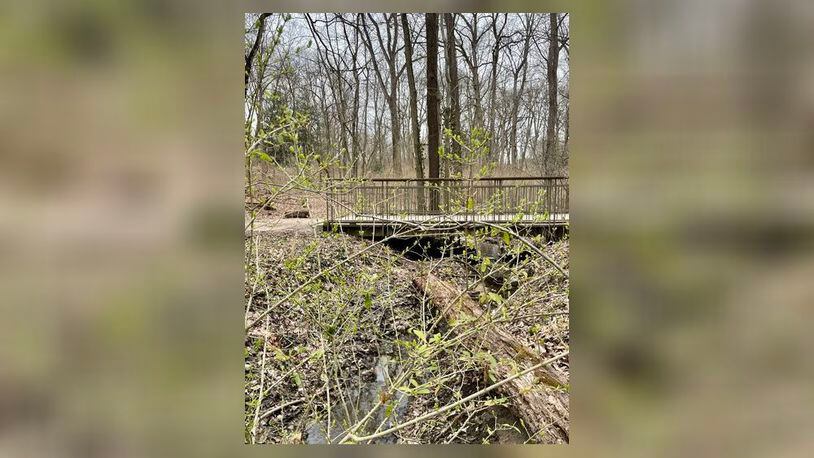The solution is simple, although a bit messy.
“Walk through the mud and not around it,” said Andy Niekamp of Dayton Hikers. “This prevents our trails from getting wider and vegetation from getting trampled.”
Niekamp also suggests checking for trail alerts or closures on park websites or Facebook pages before venturing out.
“Spring rain can bring flooded creeks and rivers and flood waters can cover and block low lying trails,” he said. “Know before you go.”
Navigating slippery, muddy trails requires preparation and patience. The Dayton Hikers weigh in with some advice on conquering challenging trails.
Navigating the trails
“If a puddle exists, take a moment and pull a big stick through the edge of a lower side to allow the puddle to drain.” – Andy Bergeron
“I recommend bringing trekking poles when walking through the slippery, muddy areas. Sunscreen is good since leaves aren’t out on the trees yet. I like hiking boots vs. shoes for more ankle stability.” – Terri Reinheimer-Kerivan
“I swear by my Merrell hikers and Bombas socks, but there are many other great choices. I always bring a light backpack for water and snacks, maybe sunscreen and bug spray for warmer months.” – Alan Limke
“For beginner hikers, I highly recommend waterproof boots and gaiters to keep comfortable in case you do hit mud. Walking sticks are helpful for balance in thick mud.” – Kristen Beireis
“Gaiters will keep some of the mud off your pants. Walk slower on muddy trails to keep from falling. If you have fallen in mud, you have officially been baptized as a true hiker.” – Laurel Slate
“Having a clean pair of shoes waiting in your car for the drive home is often a good idea. Muddy boots can go in a plastic bin on the floor of your car or in the trunk, so your car doesn’t get muddy.” – Elizabeth Delaney
Steering clear of the mud
If you’d prefer to keep your hiking boots clean, there are some alternatives to natural surface trails. Dayton Hikers offer some suggestions.
“For people who don’t have specialized gear or don’t want to deal with all of the mud, any of the area bike trails provide opportunities to get out in nature. My favorite is the Little Miami Scenic Trail, specifically the sections from Xenia to Yellow Springs and from Xenia to Corwin. Both sections cross or run along rivers and streams and are beautiful this time of year. There are multiple access points, so people can choose whatever length of hike that suits them.” – Luwanna Linkhart
“The forested parts of the purple trails at Possum Creek and Germantown are in decent shape right now. So are the Heron and Ghost trails at Sycamore State Park. For paved, I’m a fan of Woodland Cemetery and the bike path that runs from Deeds Point up to Wegerzyn. Our bike paths are a really nice option right now because not only do you still get to enjoy plenty of wildlife and foliage, you’re helping give those soupy trails a chance to rest.” – Katie Thimons
“The purple trail at Bill Yeck (Smith House entrance) is a good choice for something that’s fairly free of mud. And the yellow trail at Cox Arboretum MetroPark is typically a good option.” – Elizabeth Delaney
“For people who want to avoid mud I recommend the bike trails, Charleston Falls and Stillwater Prairie Reserve, where they have gravel down on the trails.” – Denyse Moore Carone
About the Author
